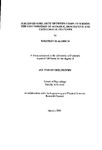PERCEIVED SIMILARITY BETWEEN COMPLEX SOUNDS: THE CONTRIBUTION OF ACOUSTIC, DESCRIPTIVE AND CATEGORICAL FEATURES
| dc.contributor.author | ALDRICH, KIRSTEEN M | |
| dc.contributor.other | Faculty of Science and Engineering | en_US |
| dc.date.accessioned | 2013-09-24T09:51:01Z | |
| dc.date.available | 2013-09-24T09:51:01Z | |
| dc.date.issued | 2005 | |
| dc.identifier | NOT AVAILABLE | en_US |
| dc.identifier.uri | http://hdl.handle.net/10026.1/1913 | |
| dc.description.abstract |
The thesis identifies some of the most salient acoustic and descriptive features employed in listeners' representations of sounds focussing on similarity judgements. A range of descriptive data (including word pair and imagery/word use) was collected alongside acoustic measures for the sound stimuli employed. The sounds employed were initially all abstract in nature but environmental sounds were included in later experiments. A painwise comparison task and a grouping task were employed to collect (dis)similarity data for multidimensional scaling and hierarchical cluster analyses. These provided visual output that represented the sounds' perceived similarities. Following participants' similarity judgements correlational techniques identified which of the acoustic and descriptive features helped to explain the dimensions identified by the MDS. Results across all nine experiments indicated that both acoustic and descriptive features contributed to listeners' similarity judgements and that the influence of these varied for the different sound sets employed. Familiarity with the sounds was identified as an additional feature that played a key role in the way participants used the available information in their grouping decisions. There was also a clear indication that the category to which a sounds source object belonged was making an important contribution to the similarity judgements for sounds rated as familiar. The work highlights a complex and variable relationship in the use of descriptive and acoustic features. Further the work has investigated the similarities and differences in participants' judgements depending on the data collection technique used i.e. pairwise comparison or grouping task. These findings have implications for the development of future models of auditory cognition. The thesis suggests that the perception of sound with particular reference to similarity is a complex interplay of features that goes far beyond understanding acoustic features alone. | en_US |
| dc.description.sponsorship | Engineering and Physical Sciences Research Council | en_US |
| dc.language.iso | en | en_US |
| dc.publisher | University of Plymouth | en_US |
| dc.title | PERCEIVED SIMILARITY BETWEEN COMPLEX SOUNDS: THE CONTRIBUTION OF ACOUSTIC, DESCRIPTIVE AND CATEGORICAL FEATURES | en_US |
| dc.type | Thesis | |
| plymouth.version | Full version | en_US |
| dc.identifier.doi | http://dx.doi.org/10.24382/4977 |
Files in this item
This item appears in the following Collection(s)
-
01 Research Theses Main Collection
Research Theses Main


